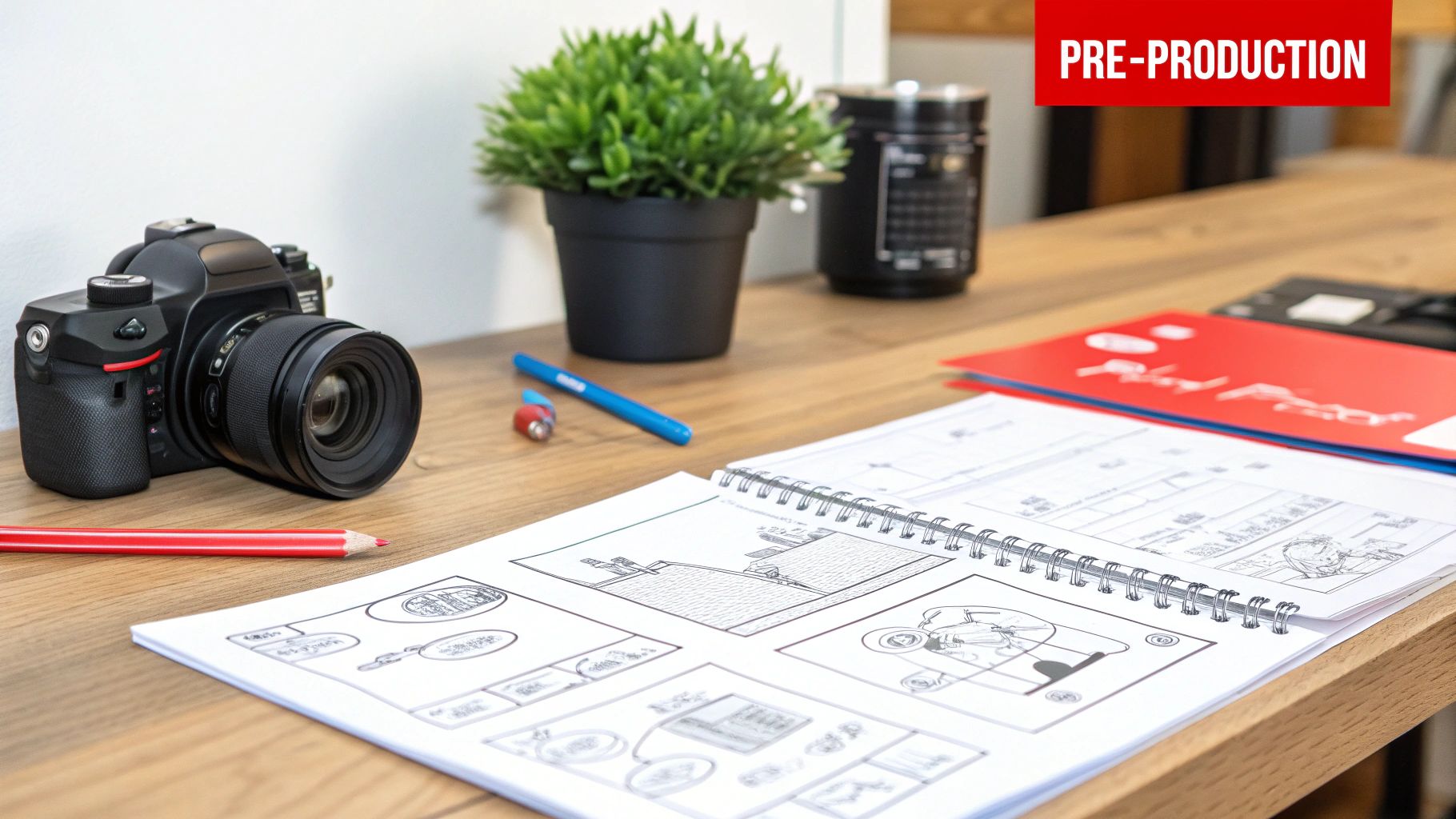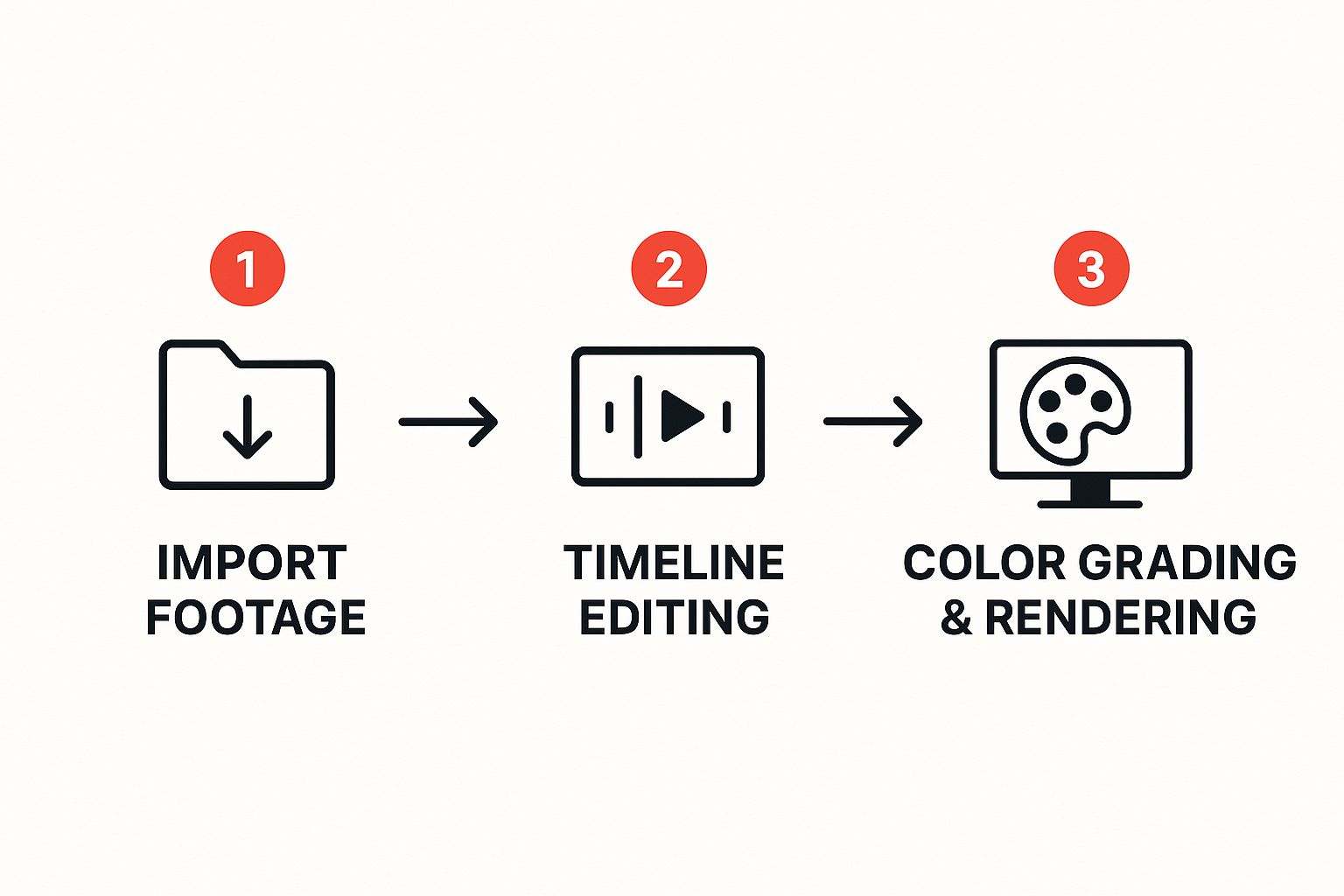The Evolving Landscape of YouTube Production

Creating compelling YouTube content requires a strategic YouTube video production workflow. The days of unplanned videos are over. A systematic process is now crucial for channels aiming for growth and lasting success. This change is due to rising competition and evolving viewer expectations.
Rising Competition and Viewer Expectations
The sheer amount of content on YouTube has created a fiercely competitive environment. Creators must produce high-quality videos and optimize their production process for efficiency and discoverability. Viewers also expect higher production values, engaging stories, and consistent uploads. This requires a structured workflow to meet these demands and avoid burnout.
For instance, pre-production planning is essential. A solid plan, including audience research, scriptwriting, and a detailed shooting schedule, can significantly reduce production time and improve the final product. This is vital in a competitive landscape where attention spans are short.
Modern audiences expect consistency. A reliable upload schedule builds anticipation and loyalty. Maintaining this consistency depends on a robust and efficient workflow. Successful creators understand this and optimize every step of their production, from initial ideas to publishing.
The Shift Towards Intentional Workflows
This competitive landscape has fundamentally changed how successful YouTubers approach their YouTube video production workflow. Workflow development isn't an afterthought; it's essential for success. This means approaching each stage—pre-production, production, and post-production—with purpose and a focus on maximizing creativity and efficiency.
Consider the increasing use of automation tools for video editing, metadata optimization, and content repurposing. Tools like Adobe Premiere Pro for editing or vidIQ for optimization free up creators to focus on making engaging content. This intentional use of technology is a hallmark of a modern, effective YouTube production workflow.
YouTube’s massive growth has also reshaped production strategies. In 2012, YouTube had roughly 0.8 billion users. By 2025, this number is projected to reach 2.7 billion, an increase of nearly 1.9 billion users over 13 years. Find more detailed statistics here. This huge expansion highlights the need for creators to adapt their workflows for a diverse global audience.
Building a Sustainable YouTube Career
A well-defined YouTube video production workflow helps creators work smarter, not harder. It allows for consistent, high-quality content while preserving creative energy. This sustainable approach is key to long-term success on YouTube. It enables creators to build thriving communities, establish their brands, and achieve their goals as the platform evolves. This focus on workflow will only become more critical as competition intensifies and viewer expectations continue to rise.
Pre-Production: Building a Foundation for Success

A successful YouTube video production workflow relies heavily on robust pre-production. This crucial stage transforms initial sparks of inspiration into a concrete plan, minimizing potential roadblocks before they impact your project. Smart creators recognize pre-production as a key advantage, setting the stage for engaging content that truly connects with their audience.
Understanding Your Audience
Effective pre-production starts with understanding your audience. This means going beyond basic demographics to explore their true interests, needs, and viewing habits. Are they seeking quick entertainment, in-depth tutorials, or something else entirely? This knowledge shapes your content strategy and ensures your videos deliver what your viewers actually want.
Successful YouTubers use audience research to inform their content decisions. They analyze comments, use polls, and monitor community forums to understand what resonates. This feedback loop refines future content, leading to greater audience engagement and satisfaction.
Scriptwriting: Balancing Authenticity and Engagement
A well-crafted script provides the backbone for any successful YouTube video. The key is to strike a balance between authenticity and engagement. While a script offers structure, it shouldn't stifle your personality. The goal is to create a roadmap that keeps you focused while still allowing for spontaneity and a genuine connection with your viewers.
Scripts should enhance, not replace, your authentic voice. Think of your script as a conversational guide. It outlines key points and ensures a logical flow while leaving room for your natural charisma to shine.
Planning For Production: Eliminating On-Set Chaos
A detailed production plan prevents on-set issues and streamlines the entire filming process. This involves scheduling shoots, securing locations, and preparing equipment. A comprehensive plan minimizes delays, allowing you to focus on capturing high-quality content efficiently. This is particularly helpful for creators juggling multiple projects or collaborating with a team.
A solid production plan offers more than just logistical benefits. It also provides a framework for creative decision-making, ensuring all elements of your video align with your overall vision. This proactive approach minimizes stress and maximizes your creative energy.
Ideation and Organization: Fueling Consistent Creativity
Developing a system for content ideation is essential for consistent output. This could include brainstorming sessions, keyword research, or analyzing trending topics. A structured approach ensures a constant flow of fresh ideas, preventing creative burnout and maintaining momentum.
Strong organization systems reduce decision fatigue throughout your YouTube video production workflow. Consider using project management tools like Asana, creating templates for common tasks, or establishing clear file-naming conventions. Such systems free up mental energy so you can focus on the creative side of your work. This is especially crucial for maintaining a consistent upload schedule for channels that prioritize regular content. The evolution of YouTube video production workflow is intertwined with audience behavior and algorithmic recommendations, which impact content creation and distribution. As of 2025, over 70% of YouTube watch time comes from algorithmic recommendations. This underscores the importance of understanding SEO, metadata optimization, and retention metrics. Explore this topic further. Creators now frequently use thumbnail testing, keyword research, and trend analysis during pre- and post-production to maximize algorithmic visibility. This strategic approach is essential in today’s competitive YouTube landscape. By optimizing for both creative vision and algorithmic reach, creators are better positioned for long-term success. This foresight allows you to adapt to the platform’s evolving demands, ensuring your content remains discoverable and engaging.
Production: Capturing Content That Connects

This infographic illustrates a typical post-production workflow. It highlights key steps, from importing raw footage to the final rendering process. A structured approach like this ensures efficient handling of footage, editing, and output. The progression, from import to timeline editing, then to color grading and rendering, emphasizes the importance of each stage in creating a polished video. Optimizing each phase helps creators maximize efficiency and output quality within their YouTube video production workflow.
However, successful production starts well before post-production. It begins with capturing compelling content. This goes beyond technical skills. It's about creating footage that offers flexibility and strong storytelling potential during the editing phase.
Shooting for the Edit: Maximizing Footage Value
Experienced YouTubers know that production is more than just hitting the record button. They shoot with the edit in mind, considering how each shot will contribute to the final video. This means capturing a variety of shots—wide, medium, and close-up—to build a dynamic visual story.
For instance, a cooking channel might use wide shots of the kitchen, medium shots of the cooking process, and close-ups of ingredients or specific techniques. This variety provides options during editing, allowing for smooth transitions and an engaging visual narrative.
Shooting Protocols and Shot Lists: Ensuring Consistency and Flexibility
Consistent quality relies on established shooting protocols. These might include standardized camera settings, lighting setups, and audio techniques. This approach minimizes on-set adjustments and saves valuable post-production time.
Creating a detailed shot list before filming is also crucial. A shot list acts as a roadmap, ensuring all necessary footage is captured. It also provides the editor with the essential elements for a compelling narrative. A comprehensive shot list offers flexibility by giving editors a range of options during post-production.
Audio Capture: Avoiding Common Pitfalls
High-quality audio is just as important as video in a YouTube video production workflow. Many creators invest in external microphones like those from Rode and use techniques to minimize background noise. This proactive approach prevents audio problems that are difficult, if not impossible, to fix later.
Imagine a travel vlog with beautiful scenery but distracting wind noise. The viewer's experience is immediately diminished. By prioritizing clean audio during production, creators deliver their message clearly and professionally.
Managing On-Camera Performance and Maintaining Energy
On-camera performance can be challenging. Successful YouTubers develop strategies to manage anxiety and maintain energy during long shoots. These might include practicing beforehand, taking regular breaks, or using visualization techniques. Efficiently organizing footage during production also prevents lost footage and streamlines the editing process.
To help visualize the equipment needs, let's take a look at the following table:
Equipment Requirements by Content Type This table compares essential equipment needed for different YouTube content formats.
| Content Type | Camera | Audio | Lighting | Additional Gear |
|---|---|---|---|---|
| Vlog | Mirrorless or DSLR camera | Lavalier microphone | Softbox or ring light | Gimbal, tripod |
| Gaming | Webcam or capture card | Gaming headset with microphone | Desk lamp or LED panels | Streaming software, green screen |
| Cooking Show | DSLR or camcorder | Shotgun microphone | Overhead lighting, backlighting | Tripod, food styling props |
| Educational Video | Webcam or DSLR | USB microphone | Ring light or softbox | Screen recording software, whiteboard |
| Music Video | DSLR or mirrorless camera | Condenser microphone | Professional lighting kit | Tripod, slider, other camera accessories |
This table highlights how equipment needs vary depending on the type of content being produced. While a vlogger might prioritize a portable setup with a gimbal and lavalier microphone, a musician might need a higher-end camera, condenser microphone, and a more complex lighting arrangement. Regardless of content type, high-quality audio and video are essential for a professional final product.
Post-Production: Editing That Keeps Viewers Watching

Post-production is where raw footage transforms into a polished YouTube video. This stage of the YouTube video production workflow isn't simply about assembling clips; it's about strategically crafting content that captivates viewers and encourages them to keep watching.
The Psychology of Editing: Pacing and Pattern Interrupts
Good editing uses psychological principles to hold viewers’ attention. Pacing, the speed and rhythm of the video, is key. A well-paced video keeps the audience engaged without feeling rushed or bored.
For example, a fast-paced edit with quick cuts might work for an action vlog. A slower pace is better suited for a tutorial or explainer video. This means using pattern interrupts is crucial.
Pattern interrupts are unexpected changes in the audio or visuals that prevent viewers from losing focus. A sudden zoom, a shift in music, or a B-roll clip can all serve as effective pattern interrupts. Producing video testimonials is also a powerful technique. For more tips on creating compelling testimonials, see this resource on Customer Testimonial Video Production.
Audio Techniques: Elevating Perceived Production Value
While visuals are important, audio significantly impacts how viewers perceive quality. Subtle audio techniques can dramatically improve the overall experience. This might involve using background music to set the mood.
It could also include adding sound effects to highlight key moments, or ensuring clear dialogue. Proper audio mixing and mastering ensure a professional and polished sound.
For example, removing background noise, balancing audio levels, and adding compression can greatly improve clarity and impact. This attention to detail communicates quality and professionalism to your audience.
Project Organization and Templates: Streamlining the Editing Process
Experienced YouTubers know efficient project organization is essential to their YouTube video production workflow. A well-organized project prevents bottlenecks and saves time. This might involve using a consistent naming convention for files.
It could also involve creating separate folders for different media types and regularly backing up the project. Templated approaches for recurring tasks, like intros, outros, and lower thirds, can drastically reduce editing time. This allows creators to focus on the core content and creative aspects of their videos.
The sheer volume of YouTube content demands structured workflows. Many creators incorporate automation and collaboration tools to manage uploads and maintain quality. In 2025, YouTube hosted over 5 billion videos, with uploads increasing by more than 360 hours every minute—about 2.6 million videos daily. This massive throughput requires creators to optimize every stage of video production, from ideation to publishing. Learn more about YouTube statistics.
Quality Control and Balancing Perfectionism
Quality control checkpoints throughout post-production help catch errors before publishing. This might involve reviewing the edit for technical glitches, checking for continuity errors, and getting feedback.
However, it’s vital to balance perfectionism with consistent output. While high quality is important, focusing too much on minor details can hinder regular uploads. This means setting realistic deadlines and prioritizing the most impactful edits.
Striking this balance allows for a consistent upload schedule without sacrificing quality. This sustainable approach is key to long-term success on YouTube.
Publishing: Turning Great Videos Into Discovered Content
You've poured your heart and soul into creating a fantastic video. But your YouTube video production workflow isn't finished just yet. Strategic publishing is the next crucial step. This is what separates videos that gain traction from those that get lost in the shuffle.
Metadata: The Key to Discoverability
Metadata is the information that tells YouTube what your video is all about. This includes your title, description, and tags. Successful creators understand that metadata isn't an afterthought. It's a critical part of the YouTube video production workflow. They use keyword research tools like vidIQ to find out what their target audience is searching for.
For example, imagine your video is about baking a chocolate cake. Using a keyword like "easy chocolate cake recipe" in your title and description can significantly improve your video's visibility. This is crucial, especially since over 70% of YouTube watch time comes from algorithm recommendations.
Thumbnails: Grabbing Viewers' Attention
Think of thumbnails as mini movie posters for your videos. They're the first thing potential viewers see, so a compelling thumbnail is key to getting those clicks. The best thumbnails are clear, visually appealing, and accurately represent the video's content.
Many creators A/B test different thumbnail options to see which performs best. Canva is a great tool for creating eye-catching thumbnails quickly and easily. Consider using bright colors, clear text, and close-ups of faces to really draw the viewer in.
First-Hour Engagement: Signaling Value to the Algorithm
The first hour after you publish a video is extremely important for YouTube’s algorithm. High engagement during this time—likes, comments, shares, and watch time—tells YouTube that your video is valuable. Smart creators have strategies to boost initial engagement.
This might involve promoting new uploads on social media or engaging with their audience in the comments section. Promoting new videos to your existing audience through email lists or dedicated social media posts can also drive a lot of traffic in those crucial first few hours. Responding to comments and answering questions helps too!
Building a Systematic Publishing Process
Don't treat publishing as a last-minute task. Instead, make it a systematic part of your YouTube video production workflow. Using templates for your descriptions and social media announcements can streamline the process. Timing is also a factor.
Understanding your audience’s viewing habits is key to optimizing your upload schedule for maximum visibility. Knowing when your viewers are most active allows you to schedule your uploads strategically, giving your videos the best chance of reaching your audience.
To help you optimize your videos for success, here's a handy checklist:
To make this easier, we've put together a handy checklist:
YouTube Video Metadata Optimization Checklist | Essential elements for optimizing your video's metadata for maximum visibility
| Metadata Element | Best Practice | Example | Impact on Performance |
|---|---|---|---|
| Title | Include relevant keywords, keep it concise and engaging | "Easy Chocolate Cake Recipe: Step-by-Step Guide" | Improves search visibility and click-through rates |
| Description | Provide a detailed summary of the video content, include relevant links and calls to action | "Learn how to make a delicious chocolate cake with this easy-to-follow recipe. Ingredients list below! Subscribe for more baking tutorials!" | Gives context to the video, drives traffic to other resources, and encourages engagement |
| Tags | Use a mix of broad and specific keywords related to your video topic | #chocolatecake #baking #recipe #dessert #easyrecipe #homemade #food | Improves search discoverability and helps YouTube categorize your video accurately |
By mastering these publishing techniques, your videos will get the attention they deserve, driving engagement and helping your channel grow.
Workflow Automation: Scaling Without Sacrificing Quality
As your YouTube channel grows and you aim for a successful brand like those on MonetizedProfiles, your YouTube video production workflow naturally becomes more complex. It's not just about producing more videos—it's about creating higher-quality content while managing your time and resources efficiently. This section explores how successful creators use automation and smart systems to scale their output without increasing their workload.
Identifying High-ROI Automation Opportunities
Begin by identifying areas in your workflow where automation offers the greatest return. These are usually repetitive, time-consuming tasks that don't demand much creativity. For example, think about automating caption generation, background noise removal, or even parts of your editing process with tools like Descript. This allows you to concentrate on the creative aspects of your content, which make your channel unique.
Templates and Standard Operating Procedures: Maintaining Consistency
Using templates can significantly streamline your workflow. Create templates for intros, outros, lower thirds, and even entire video structures. This ensures consistent branding across your content and saves time on repetitive design work. Also, develop clear Standard Operating Procedures (SOPs) for common tasks. SOPs provide step-by-step instructions, reducing decision fatigue and ensuring everyone on your team uses the same efficient process. This is particularly valuable for tasks like metadata optimization or publishing, where consistency is key for maximizing discoverability.
Effective Delegation and Quality Control
As your channel grows, delegating certain production elements becomes crucial. However, maintaining creative control is essential. Establish a system where you clearly communicate your vision to team members or freelancers while giving them the freedom to do their jobs effectively. Implement quality control checkpoints throughout your workflow. This might involve reviewing edits for technical issues, checking audio quality, or verifying factual accuracy. These checks prevent mistakes and maintain the high quality viewers expect.
Leveraging AI Tools Strategically
AI tools are changing the YouTube video production workflow. However, they're most effective when used strategically. Consider using AI for tasks like keyword research, thumbnail generation, or content repurposing. For example, tools like Opus Clips can automatically create YouTube Shorts from longer videos. This saves time and helps you reach a broader audience. Remember, AI should support your creative decisions, not replace them.
By strategically implementing these automation strategies, you can scale your YouTube channel efficiently while maintaining the high-quality content that attracts and retains your audience. Consider using document processing automation to streamline repetitive tasks within your YouTube workflow. This approach lets you maintain consistent output and preserve your creative energy, a critical factor for long-term success on YouTube.
Adapting Your Workflow Across Content Formats
A strong YouTube video production workflow is essential for success. However, it's important to remember that different types of content require different approaches. Think about the variety you see on YouTube: long-form videos, quick Shorts, live streams, and even experimental content. Each has its own unique demands. To successfully manage this, you need a flexible system that can adapt.
Maintaining Brand Identity Across Formats
Even though each format needs a unique approach, keeping your brand identity consistent is key. This means using similar visuals, messaging, and tone across all your content. Imagine your brand as a person – whether they're telling a long story or a short joke, their personality should still shine through.
For example, an educational channel might use the same intro music, graphics, and color scheme for both long videos and Shorts. This helps viewers recognize your brand no matter where they find your content. This consistency builds trust and a stronger sense of community.
Modifying Production Standards
While brand consistency is vital, your production standards can and should change between formats. A polished, scripted video essay requires a different approach than a spontaneous Short or live stream. It's like using the right tool for the job.
Consider the difference between a channel's weekly in-depth video and its daily Shorts. The main video might use multiple cameras, professional lighting, and lots of editing. The Shorts, however, could be filmed on a smartphone with minimal post-production. This flexibility allows frequent uploads without impacting the quality of your core content. It's about working smarter, not harder.
Planning for Repurposing and Implementing Format-Specific Templates
Smart creators plan their content with repurposing in mind. This means thinking about how one piece of content can be used across different formats. For example, a long video could be cut into shorter clips for Shorts, key takeaways could become social media graphics, and the audio could be a podcast episode. This stretches the value and reach of your content.
Using format-specific templates can greatly speed up production. This could include templates for intros, outros, lower thirds, or even entire video structures. Having these pre-made elements eliminates repetitive work and ensures consistent branding. You could even consider using document processing automation to streamline your workflow. This frees up your time to create engaging content.
Balancing Audience Expectations and Creator Resources
Finding a sustainable upload schedule is essential. This means balancing what your audience expects with the resources you have. While viewers appreciate regular uploads, a realistic schedule is more important. It’s better to upload high-quality content less often than to burn out trying to do too much.
This balance lets you experiment with new formats without overloading your workflow. You can test what works best for your audience and creative process without stretching yourself too thin.
Ready to grow your YouTube channel? MonetizedProfiles offers monetization-approved accounts to help you succeed. Visit MonetizedProfiles and discover how they can help you reach your goals.






